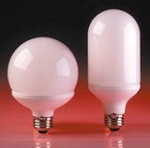Search engine visitors - click here to access entire "$ensible Home" web site
Click here to see a descriptive illustration of several new designs of compact fluorescent lights.
Dear Jim: I went to my home center store to get compact fluorescent bulbs because they save money and may help my children read and study better. How can I determine which are most economical and best for the kids? - Pat F.

A: Many people know compact fluorescent lights (CFL's) save money, but are not aware of the other benefits of high-quality special CFL's. You will probably want to buy different quality CFL's for various locations in your house. There are many shapes to fit any lamp or lighting fixture.
I have used standard CFL's for years to save electricity, but I recently tested some of the new high-visual-acuity CFL's in my own home. I normally wear reading glasses, but I can often read under these new lights without my glasses. All CFL's use about 75 percent less electricity than standard bulbs.
CFL's also last 10 to 12 times longer than incandescent bulbs. With many standard CFL's priced as low as $7 today, the lower bulb replacement cost is an additional savings. Over the life of a CFL, the total savings can be $55 for each lamp.
The least expensive CFL's are energy efficient and acceptable lighting for hallways, closets and general lighting. These will have a CRI (color rendition index) of about 60 to 70. The CRI rating indicates how true colors look under the light. The next level of CFL's have a CRI of about 85. This is what you will generally find at home center stores.
The special CFL's that make it easier to read without glare and to work with fine detail are often called "full-spectrum" because they simulate the sun. Check for this on the packaging. Their CRI is in the 93 to 96 range.
These full-spectrum bulbs produce a higher ratio of scotopic light to photopic light, similar to the sun. Lawrence Berkeley Laboratory has researched the effects of scotopic light on vision. This causes the pupil to close down which reduces glare, increases the focusing depth of field and reduces eye strain for easier reading.
When selecting your CFL's at the home center store, look for ones with integral electronic ballasts built into the base. The ballast controls the amount of electric current that flows through the bulb. Electronic ballasts reduce annoying flicker and any buzzing sounds.
If you have the lamp or light fixture on a dimmer switch, make sure to purchase dimmable CFL's. Standard CFL's will not operate if you attempt to dim them. There are also new three-way CFL's which will fit in any lamp with a three-way socket. For lamps with a large shade, consider using a circular CFL. These have a separate electronic ballast base which lasts three times longer than the replaceable bulbs.
Instant Download Update Bulletin No. 936 - buyer's guide of compact fluorescent bulbs/fixture manufacturers (standard and full-spectrum for easy reading) listing types (intergral or modular), light quality CRI ratings, ballast types (electronic or magnetic), styles/shapes with illustrations, a guide to lighting, savings chart from using high-efficiency lighting ,and a room-by-room lighting guide.
Dear Jim: We use a heat pump in our home. I noticed the backup resistance heat seems to come on, but the outdoor condenser fan stops running for a while. Is this correct operation? - Sandi J.
A: This is correct operation, particularly in cold climates. It is called a defrost cycle to keep ice from forming on the coils in the outdoor unit. The air around these coils gets extra cold during winter.
What happens is the heat pump switches to air-conditioning mode and the outdoor fan stops to heat the outdoor coils and melt any ice. In order to keep cold air from blowing out indoors during this cycle, the backup heat comes on.